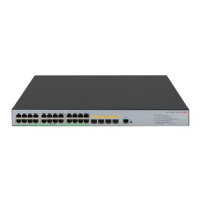179
• DR_Priority (for PIM-SM only)—Priority for DR election. The device with the highest priority wins the
DR election. You can configure this parameter on all the routers in a multi-access network directly
connected to multicast sources or receivers.
• Holdtime—The timeout time of PIM neighbor reachability state. When this timer times out, if the
router has received no hello message from a neighbor, it assumes that this neighbor has expired or
become unreachable.
• LAN_Prune_Delay—The delay of prune messages on a multi-access network. This option consists of
LAN-delay (prune message delay), override-interval, and neighbor tracking flag. If the LAN-delay
or override-interval values of different PIM routers on a multi-access subnet are different, the largest
value takes effect. If you want to enable neighbor tracking, be sure to enable the neighbor tracking
feature on all PIM routers on a multi-access subnet.
The LAN-delay setting will cause the upstream routers to delay processing received prune messages. The
override-interval sets the length of time that a downstream router can wait before sending a prune
override message. When a router receives a prune message from a downstream router, it does not
perform the prune action immediately. Instead, it maintains the current forwarding state for a period of
LAN-delay plus override-interval. If the downstream router needs to continue receiving multicast data, it
must send a join message within the prune override interval. Otherwise, the upstream router will perform
the prune action when the period of LAN-delay plus override-interval times out.
A hello message sent from a PIM router contains a generation ID option. The generation ID is a random
value for the interface on which the hello message is sent. Normally, the generation ID of a PIM router
does not change unless the status of the router changes (for example, when PIM is just enabled on the
interface or the device is restarted). When the router starts or restarts sending hello messages, it
generates a new generation ID. If a PIM router finds that the generation ID in a hello message from the
upstream router has changed, it assumes that the status of the upstream neighbor is lost or that the
upstream neighbor has changed. In this case, it triggers a join message for state update.
If you disable join suppression (namely, enable neighbor tracking), be sure to disable the join
suppression feature on all PIM routers on a multi-access subnet. Otherwise, the upstream router will fail
to explicitly track join messages from downstream routers.
Configuring hello options globally
Ste
Command Remarks
1. Enter system view.
system-view N/A
2. Enter public network PIM view
or VPN instance PIM view.
pim [ vpn-instance
vpn-instance-name ]
N/A
3. Configure the priority for DR
election.
hello-option dr-priority priority
Optional.
1 by default.
4. Configure PIM neighbor
timeout time.
hello-option holdtime interval
Optional.
105 seconds by default.
5. Configure the prune message
delay time (LAN-delay).
hello-option lan-delay interval
Optional.
500 milliseconds by default.

